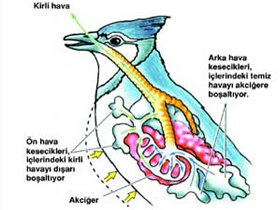Another factor that makes the scenario of evolution from dinosaur to bird impossible is the unique structure of the avian lung, which cannot be explained in evolutionary terms.
The lungs of terrestrial animals have a two-way structure: During inhalation, air travels down into the lungs through increasingly narrower channels, halting at tiny air sacs, where the exchange of oxygen and carbon dioxide takes place. Later, this CO2-laden air moves in the opposite direction, leaving the lung by the same path through which it entered, and is expelled through the main bronchial passage.
In birds, on the other hand, the air travels in one way only along the so-called pulmonary canal. The lungs' entry and exit canals are different from one another, and air always travels in the same direction, thanks to the special air sacs extending along the passages. This means a bird can absorb oxygen in the air non-stop, meeting its high energy requirements.
In the case of birds, the major bronchi break down into tiny tubes which permeate the lung tissue. These so-called parabronchi eventually join up together again, forming a true circulatory system so that air flows in one direction through the lungs. . . [T]he structure of the lung in birds and the overall functioning of the respiratory system is quite unique. No lung in any other vertebrate species is known which in any way approaches the avian system. Moreover, it is identical in all essential details in birds as diverse as humming birds, ostriches and hawks.83
It is impossible for the reptilian lung, with its two-way air flow, to have evolved into the avian lung, with a one-way flow. No transitional stage between these two pulmonary structures is possible. Any vertebrate must breathe in order to survive, and the first step in any change of pulmonary structure would lead to the death of that intermediate stage.
Furthermore, the theory of evolution maintains that all changes took place gradually, over millions of years. Yet no creature whose lungs do not function can survive for more than a few minutes.
This one-directional flow of air is maintained in breathing in and breathing out by a complex system of interconnected air sacs in the bird's body, which expand and contract in such a way as to ensure a continuous delivery of air through the parabronchi . . . The structure of the lung in birds, and the overall functioning of the respiratory system, are quite unique. No lung in any other vertebrate species in any way approaches the avian system. Moreover, in its essential details, it is identical in [all] birds.84
In short, a transition from one type of lung to the other is not possible, because no "transitional" lung could function properly.
In addition, reptiles have a diaphragmatic respiratory system, while birds have no diaphragm. The differing structures also make evolution between the two types impossible. John Ruben, an authority on respiratory physiology, comments:
The earliest stages in the derivation of the avian abdominal air sac system from a diaphragm-ventilating ancestor would have necessitated selection for a diaphragmatic hernia in taxa transitional between theropods and birds. Such a debilitating condition would have immediately compromised the entire pulmonary ventilatory apparatus and seems unlikely to have been of any selective advantage.85
Still another feature refuting the evolution of the avian lung is that its structure leaves it never empty of air, and faces the danger of collapse if it should become empty. Michael Denton has this to say:
Just how such a different respiratory system could have evolved gradually from the standard vertebrate design without some sort of direction is, again, very difficult to envisage, especially bearing in mind that the maintenance of respiratory function is absolutely vital to the life of the organism. Moreover, the unique function and form of the avian lung necessitates a number of additional unique adaptations during avian development. As H. R. Dunker, one of the world's authorities in this field, explains, because first, the avian lung is fixed rigidly to the body wall and cannot therefore expand in volume and, second, because of the small diameter of the lung capillaries and the resulting high surface tension of any liquid within them, the avian lung cannot be inflated out of a collapsed state, as happens in all other vertebrates after birth. The air capillaries are never collapsed as are the alveoli of other vertebrate species; rather, as they grow into the lung tissue, the parabronchi are from the beginning open tu bes filled with either air or fluid.86
This system, totally different from the lungs of reptiles and other terrestrial vertebrates, cannot have formed gradually through unconscious mutations, as evolution maintains. Denton states that the avian lung's structure invalidates Darwinism:
The avian lung brings us very close to answering Darwin's challenge: "If it could be demonstrated that any complex organ existed, which could not possibly have been formed by numerous, successive, slight modifications, my theory would absolutely break down."87
83. Michael Denton, Evolution: A Theory in Crisis, pp. 210-211.
84. Ibid., pp. 211-212.
85. J. A. Ruben, T. D. Jones, N. R. Geist, and W. J. Hillenius, "Lung Structure And Ventilation in Theropod Dinosaurs and Early Birds," Science, Vol. 278, p. 1267.
86. Michael J. Denton, Nature's Destiny, New York: Free Press, 1998, p. 361.
87. Ibid., pp. 361-362.


